Shoulder Pain: Symptoms, Causes & Treatment
Austin Chiropractor, Dr. Daniel Has an Excellent Track Record Treating Shoulder Pain.
Shoulder Pain
Shoulder Pain is one of the most common conditions that Austin Chiropractor Dr. Daniel treats. Whether it's frozen shoulder, adhesive capsulitis, rotator cuff injuries or bicipital tendonitis, Dr. Daniel is an Austin Chiropractor who has seen it all.
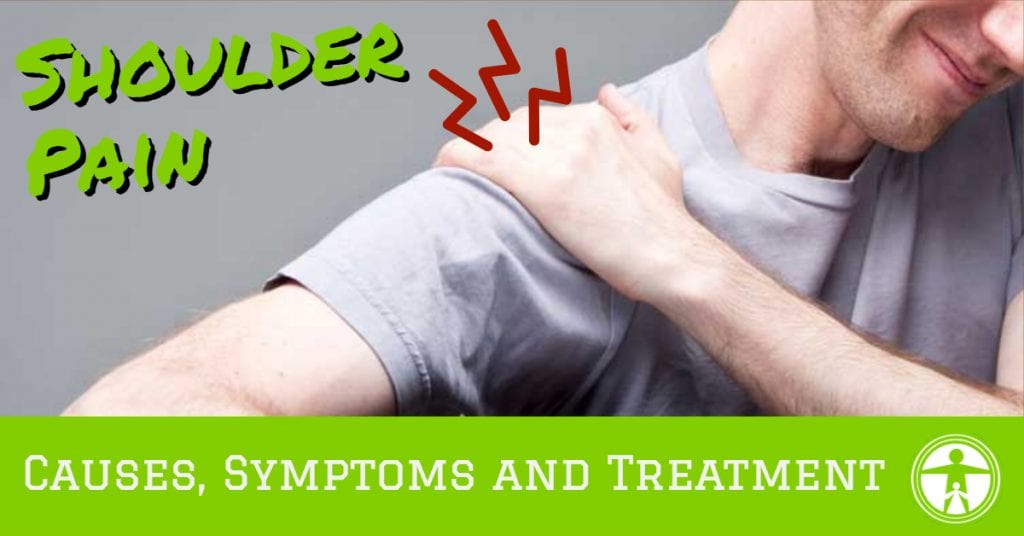
There are many reasons why you can have shoulder pain. It's very common to injure it in a fall or accident, or while doing every day activities such as taking out the trash, lifting grocery bags, helping children in the back of the car or lifting heavy objects over head. Sometimes shoulder pain is due to conditions like arthritis or compressed nerves. It can even stem from problems in other parts of your body, which is called referred pain.
Structures of Your Shoulder
The shoulder is made up of 3 bones: upper arm bone (humerus), shoulder blade (scapula), and the collarbone (clavicle).
The top part of the humerus (arm) locks into the scapula (shoulder blade), similar to how your femur (leg bone) locks into your pelvis (hip). This socket is called the glenoid. A combination of muscles and tendons keeps your arm bone centered in your shoulder socket. These muscles are called the rotator cuff muscle. They cover the head of your upper arm bone and attach it to your shoulder blade.
What Causes Shoulder Pain?
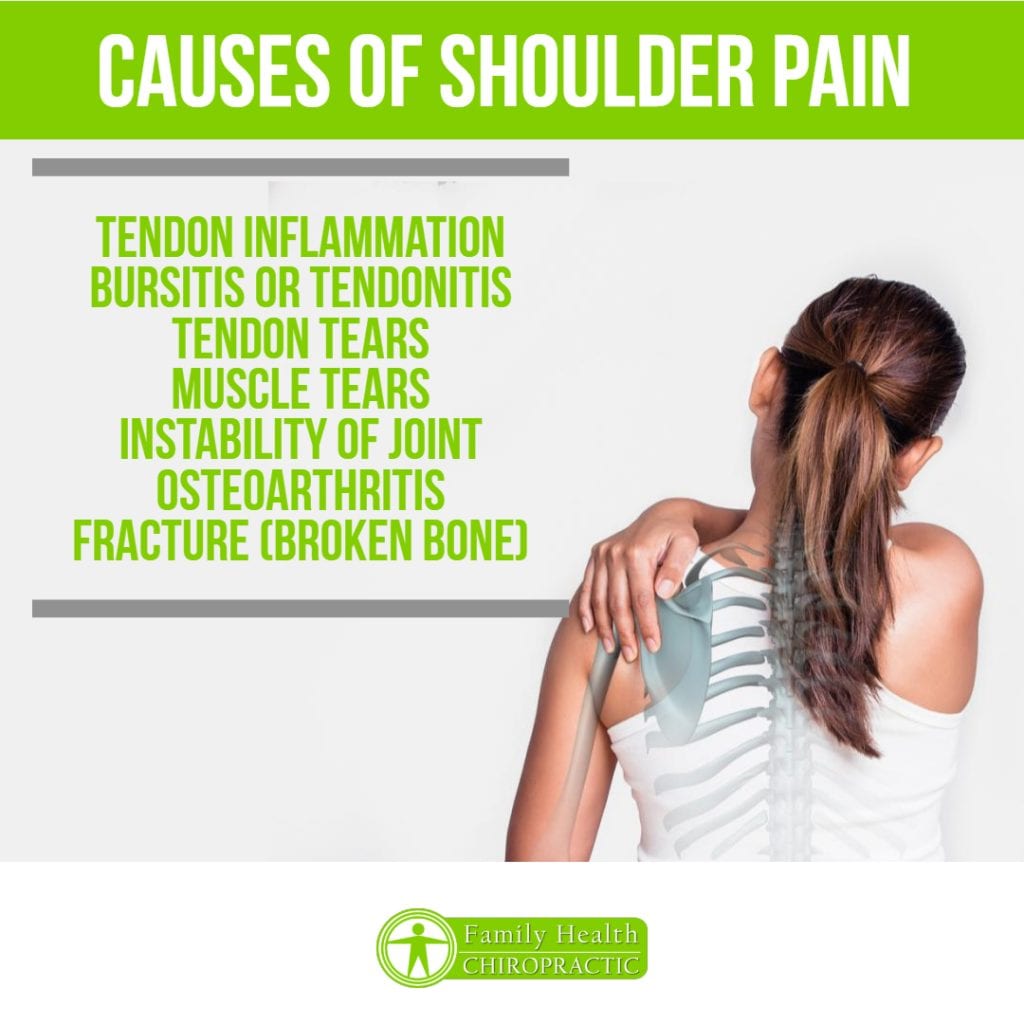
- Tendon inflammation (bursitis or tendinitis) or tendon tear
- Instability
- Arthritis
- Fracture (broken bone)
Other much less common causes of shoulder pain are tumors, infection, and nerve-related problems.
Most Common Causes of Shoulder Pain
Bursitis
Bursae are small, fluid-filled sacs that are located in joints throughout the body, including the shoulder. They act as cushions between bones and the overlying soft tissues, and help reduce friction between the gliding muscles and the bone.
Sometimes, excessive use of the shoulder leads to inflammation and swelling of the bursa between the rotator cuff and part of the shoulder blade known as the acromion. The result is a condition known as subacromial bursitis.
Bursitis often occurs in association with rotator cuff tendinitis. The many tissues in the shoulder can become inflamed and painful. Many daily activities, such as combing your hair or getting dressed, may become difficult.
Tendinitis
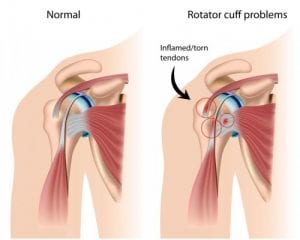
Generally, tendinitis is one of two types:
- Acute. Excessive ball throwing or other overhead activities during work or sport can lead to acute tendinitis.
- Chronic. Degenerative diseases like arthritis or repetitive wear and tear due to age, can lead to chronic tendinitis.
The most commonly affected tendons in the shoulder are the four rotator cuff tendons and one of the biceps tendons. The rotator cuff is made up of four small muscles and their tendons that cover the head of your upper arm bone and keep it in the shoulder socket. Your rotator cuff helps provide shoulder motion and stability.
Tendon Tears
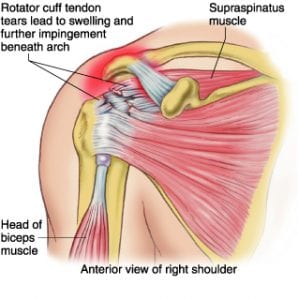
Impingement
Shoulder impingement occurs when the top of the shoulder blade (acromion) puts pressure on the underlying soft tissues when the arm is lifted away from the body. As the arm is lifted, the acromion rubs, or “impinges” on, the rotator cuff tendons and bursa. This can lead to bursitis and tendinitis, causing pain and limiting movement.
Shoulder Joint Instability
Shoulder instability occurs when the head of the upper arm bone is forced out of the shoulder socket. This can happen as a result of a sudden injury or from overuse.
Shoulder dislocations can be partial, with the ball of the upper arm coming just partially out of the socket. This is called a subluxation. A complete dislocation means the ball comes all the way out of the socket.
Once the ligaments, tendons, and muscles around the shoulder become loose or torn, dislocations can occur repeatedly. Recurring dislocations, which may be partial or complete, cause pain and unsteadiness when you raise your arm or move it away from your body. Repeated episodes of subluxations or dislocations lead to an increased risk of developing arthritis in the joint.
Shoulder Osteoarthritis
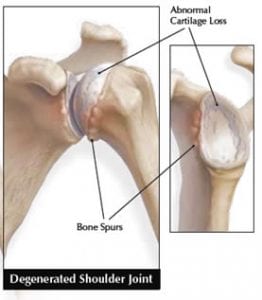
Osteoarthritis, may be related to sports or work injuries or chronic wear and tear. Other types of arthritis can be related to rotator cuff tears, infection, or an inflammation of the joint lining.
Often people will avoid shoulder movements in an attempt to lessen arthritis pain. This sometimes leads to a tightening or stiffening of the soft tissue parts of the joint, resulting in a painful restriction of motion.
Fracture
Fractures are broken bones. Shoulder fractures commonly involve the clavicle (collarbone), humerus (upper arm bone), and scapula (shoulder blade).
Shoulder fractures in older patients are often the result of a fall from standing height. In younger patients, shoulder fractures are often caused by a high energy injury, such as a motor vehicle accident or contact sports injury.
Fractures often cause severe pain, swelling, and bruising about the shoulder.
Diagnosing Shoulder Pain
In the case of an acute injury causing intense pain, we recommend seeking medical care as soon as possible.
The first goal in our office is to conduct a thorough evaluation in order to determine the cause of your shoulder pain and provide you with the best treatment options.
Tests
In order to assess shoulder problems we may request any of the following:
- X-rays. These pictures will show any injuries to the bones that make up your shoulder joint.
- Magnetic resonance imaging (MRI) and ultrasound. These imaging studies create better pictures of soft tissues. MRI may help your doctor identify injuries to the ligaments and tendons surrounding your shoulder joint.
- Computed tomography (CT) scan. This tool combines x-rays with computer technology to produce a very detailed view of the bones in the shoulder area.
- Electrical studies. Your doctor may order a test, such as an EMG (electromyogram), to evaluate nerve function.
- Arthrogram. During this x-ray study, dye is injected into the shoulder to better show the joint and its surrounding muscles and tendons. It may be combined with an MRI.
- Arthroscopy. In this surgical procedure, your doctor looks inside the joint with a fiber-optic camera. Arthroscopy may show soft tissue injuries that are not apparent from the physical examination, x-rays, and other tests. In addition to helping find the cause of pain, arthroscopy may be used to correct the problem.
Shoulder Pain Treatment
Treating this condition will ultimately depend on the actual cause.
Generally speaking, treatment options will include rest, heat or cold therapy, physical therapy, prescription medications, chiropractic care and in rare cases… surgical procedures.
Austin Chiropractor Dr. Daniel is skilled in identifying the true cause, as well as recommending the most non-invasive and effective treatments for shoulder pain.
Neck Pain Treatment In Austin
If you live in the Austin area and are suffering from neck pain, let Austin Chiropractor Dr. Daniel help you figure it out!
Here at Family Health Chiropractic, treatment of fatigue is only the beginning of how we can help you live a happy, healthier life.
Click here to sign up for a consultation with Austin’s Best Chiropractor today!

